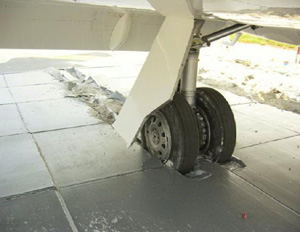
How could EMAS save planes? EMAS systems can bring planes that overshoot the runway to a safe and rapid stop. EMAS stands for Engineered Materials Arresting System, and they are being introduced into some airports.
Runways around the world come in a variety of lengths, and planes need different lengths depending on a whole variety of factors. It depends on their weight, their thrust power, their size, the temperature, the wind, and even the altitude. The world’s longest runway is in Tibet, and it is 5,500 meters long because it is very high up and planes need more time to get up take off speed at that altitude. No matter how long the runway, planes can always overshoot it.
There are two ways planes can overshoot a runway. They can either overshoot it when taking off or when landing. When taking off, planes have a speed which is called V1. This is the speed at which the pilot must decide whether to take off or not. After this speed, the plane can no longer safely be brought to a stop. Even if there is a problem, the plane must fly. There is simply not enough runway left to be able to stop the plane. If a pilot tries to abort after V1, the plane will probably overshoot the runway. It is probably more common for planes to overshoot the runway when they land. This can happen if they land too far down the runway or if they have a problem and can’t use their brakes or reverse thrusters. If they cannot stop, they will go off the end of the runway. Sliding off the runway doesn’t sound that bad, but there are usually buildings, roads, canyons, and a whole host of other things at the end of runways. The most recent example of this was in 2024 when Jeju Air Flight 2216 was hit by birds and had to make an emergency landing with out landing gear. It landed too far down the runway, skidded on its belly, went off the end of the runway ,and hit a concrete barrier, where it exploded. 179 people died. If the airport had had an EMAS system, the result might have been different.
To prevent deaths when planes overshoot runways, a runway safety area is required by law in most countries. This is a space at the end of the runway, which isn’t paved, but which doesn’t have any buildings or objects on it and is flat. This area is required to be 90 m long, but the recommendations are that it should be 300 m or longer. A space like this is better than nothing, but a lot of airports don’t have the space at the end of runways to make a safety area. They are usually close to roads, or rivers, or other obstacles. There are more larger planes, such as the Airbus A380. A short safety area wouldn’t make a lot of difference to a plane that size. EMAS would work, though.
So, how does an Engineered Materials Arresting System work? It is the same idea behind the gravel pits you find on slopes for trucks to drive into if their brakes fail and they can’t stop. It needs to take away the kinetic energy of the moving object as quickly as possible. EMAS is usually made of a crushable material, like cellular concrete. The concrete blocks are secured to the end of the runway so they cannot move, but they are designed to collapse on impact. When the plane overshoots the runway and the landing gear enters the concrete, the weight of the plane crushes the concrete blocks. The kinetic energy of the plane is transferred to the energy to crush the blocks and to heat from friction. It is dissipated through the blocks and brings the plane to a rapid, but fairly smooth, stop. The same thing happens when a truck drives into a gravel pit.
EMAS can be wonderful when there is no space at the end of the runway, but a runway safety area is always the best bet, and the larger the better. EMAS systems are expensive to implement, and more space is usually cheaper. They are only worth having where there is no space. They are also only designed to stop planes up to 130 km/h. It will probably work on faster planes, but the concrete blocks could potentially tear the landing gear off the plane, and it might sail over, or even spin. That is unlikely, though. There is also the problem that a lot of times, planes don’t go straight off the end of the runway, but leave it at some other point. You cannot put EMAS all around the runway. Still, for runways without much space, EMAS is an excellent system.
Sources
https://en.wikipedia.org/wiki/Runway_excursion
https://www.faa.gov/newsroom/engineered-material-arresting-system-emas-0
https://en.wikipedia.org/wiki/Engineered_materials_arrestor_system
https://www.guinnessworldrecords.jp/world-records/63151-longest-runway
https://en.wikipedia.org/wiki/Runway_safety_area
https://skybrary.aero/articles/engineered-materials-arresting-system-emas
https://medium.com/faa/boosting-runway-safety-f9767da684fb
https://skybrary.aero/sites/default/files/bookshelf/3269.pdf
Image By National Transportation Safety Board – http://lessonslearned.faa.gov/ll_main.cfm?TabID=4&LLID=56&LLTypeID=2, Public Domain, https://commons.wikimedia.org/w/index.php?curid=34840841
